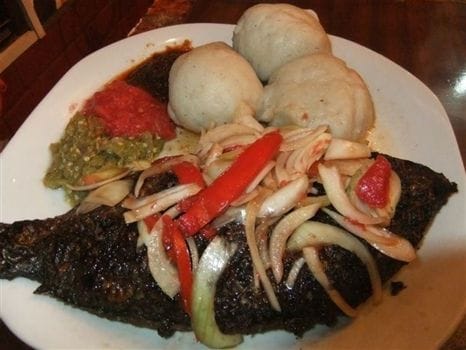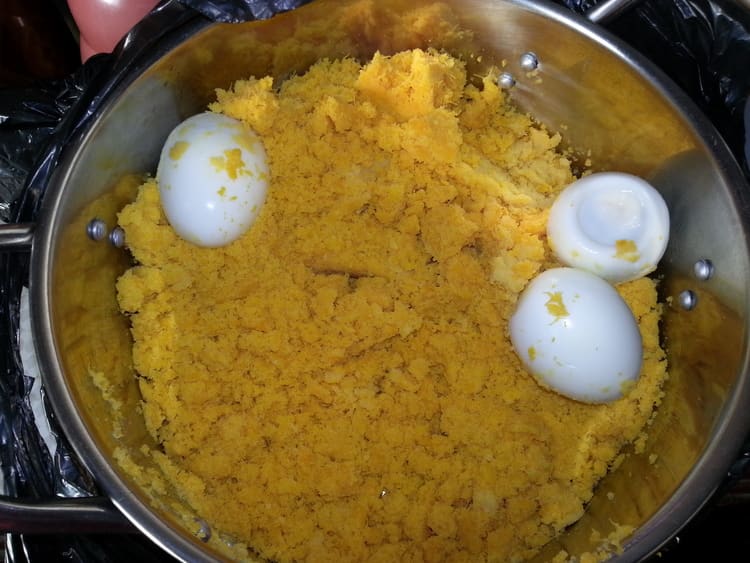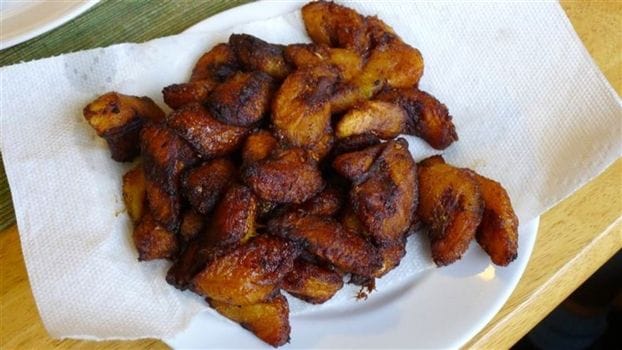Ghana’s Culinary Soul On Your Plate
If you’ve already fallen in love with Ghana, get ready to fall in love with its food too. These six traditional dishes — from hearty rice to spicy plantains — are easy to make and full of flavours in every bite. While Ghanaian cuisine is known for its bold use of chili and ginger. Dishes like Kelewele and Light Soup can pack heat, but spice levels are always adjustable.
Jollof Rice
Jollof rice is a staple and a festive favorite served at weddings, birthdays, and almost every celebration across Ghana. It is also one of West Africa’s most iconic dishes. Variations spark friendly rivalry between countries, especially Nigeria and Ghana. Each region puts its own spin on the recipe, but the heart of jollof lies in the shared tradition of tomato‑based rice cooked with meat and spices. And yes, Ghana has the best version (you can ask any local).
Jollof traces back to the Senegambian region, historically home to the Jollof Empire. The dish spread across West Africa via trade and cultural exchange, morphing in each country. In Ghana, jollof is bold, smoky, and spiced just right — often cooked over wood fires. Ghana’s version typically uses fragrant jasmine rice and a deeper tomato base compared to the Nigerian style, which often includes more vegetables and parboiled rice. This one‑pot rice dish is cooked with tomatoes, onions, spices, and chicken, resulting in fragrant, savory goodness.
Ingredients:
- ¼ cup white rice
- 1 pound skinless chicken
- 1 medium-sized onion (chopped)
- 2 teaspoons vegetable oil
- 6 ounces tomato paste
Directions:
- If only counting the ingredients brought some water to your mouth, then grab a saucepan, fry the rice and the onion on low heat until the onion becomes translucent. Don’t forget to cover the saucepan with a lid!
- Boil the chicken and cut it into small cubes and throw them into the pot.
- Pour the tomato paste and the chicken soup (successively, not all at once) and let the mixture simmer.
- Cover the pot and turn the heat down to low.
- Cook over low heat until the rice is soft and the liquid is fully absorbed (around 25 minutes).
Kenkey (Ground Cornmeal)
Kenkey is a fermented cornmeal dumpling steamed in natural wrappers (like banana leaves), often served with fish and pepper sauce, creating a distinctly Ghanaian flavor. This dumpling-style dish traces back to the Ga and Fante communities of Ghana. Known as kɔmi by the Ga and dokono by the Akans, kenkey is known throughout Ghana and even in eastern Côte d’Ivoire, Togo and Benin.
Ingredients:
- 8 cups cornmeal Cornhusks (or banana leaves)
- 1 tablespoon vinegar
- 1 cup water
Directions:
- In large pot, mix the cornmeal with just enough water to form a homogenous mass.
- Cover the pot with a cloth and let it sit in a warm place for about 6 hours.
- Pour vinegar over the cornmeal and mix.
- Wash your hands properly with non-perfumed soap and knead the dough formed in the previous stages until all the ingredients are thoroughly combined and a little stiffened. Split the dough in half.
- In a large pot bring water to a boil. Put half of the dough into the water and cook for 10 minutes stirring continuously and vigorously. Remove from heat.
- Now, mix the cooked and the uncooked dough and stir well to combine.
- Divide the mixture into serving sizes and wrap them in banana leaves (if not available, you can use aluminum foil).
- Put the wrapped pieces on a wire rack on top of a large pot with water.
- Bring the water to a boil and steam the wrapped cornmeal dough for 1-3 hours. Ready!
Oto (or Yam and Eggs)
Oto is a breakfast and comfort food dish, made of mashed yam mixed with a savoury palm‑oil sauce and topped with boiled eggs. Also called Otor or Eto, this dish is also known as a ritual food in many families. The Akan people of Ghana prepare it for special ceremonies — such as baby naming rituals, puberty rites, or twin festivals. The boiled eggs often symbolize fertility, life, and blessings.
Ingredients:
- 2 cups mashed yams
- 2 tablespoons grated onions (you will cry a little, but it’s worth it)
- ½ cup palm oil
- 1 ripe, peeled tomato
- 6 hard-boiled eggs
- Salt and pepper (to taste)
Directions:
- Boil the yams and mash smoothly with a fork
- In a saucepan, make a sauce with palm oil and onion, plus salt and pepper to taste. When the onion becomes golden. Add the tomato sauce, mix to combine and remove from heat.
- Cut 2 of the boiled eggs in half and remove the yolks. Add them to the sauce, mash and stir until combined.
- Pour this mixture over the mashed yams and mix well until it all becomes even in colour.
- Breakfast is ready! Transfer everything into a bowl and use the rest of the eggs to decorate the dish.
Kelewele (Fried Plantains)
Spicy, sweet, and crispy - Ghana’s fiery answer to a sweet tooth. These spiced, golden-fried plantain chunks are street food perfection. While fried plantains are common across West Africa, kelewele’s spice blend — often including ginger, cayenne, and cloves — makes it uniquely Ghanaian. At night markets, you will find these sold in whrapped brown paper.
Ingredients:
- 6 ripe plantains
- 1 teaspoon ginger powder
- ½ teaspoon ground red pepper
- 3 cups oil (or shortening)
- 2 tablespoons water
Directions:
- Peel and cut the plantain diagonally into ½-inch pieces. Make sure you remove all the woody parts from the centre of the fruit.
- Mix red pepper, ginger and salt well in a mixing bowl until fully combined.
- Drop the plantain slices into the spicy mix to coat them. You can also make these in air-fryer. Toss lightly oiled spiced plantains in the basket and cook at 375°F for 10–12 minutes, flipping halfway.
- In a big skillet, warm up oil and fry the coated plantain until it turns golden-brown.
Kentumere (Fish and Spinach in Tomatoes)
Also called "kontomire" stew or "palava" sauce, Kentumere blends smoked fish, spinach, and palm oil into a comforting, nutrient-rich dish. It is a light yet nutritious dish, full of essential omega-3s and 6s to keep your brain young and well functioning. Every healthy diet should include these ingredients:
- 1 cup chopped onions
- 1 cup tomatoes
- 1 cup palm oil
- 4 cups fresh spinach (chopped)
- 1 cup kippered herring
- 1 teaspoon cayenne pepper
Though enjoyed across West Africa, some believe it originated in Elmina, a coastal town with Portuguese influences — possibly where the word "palava" (from "palavra" meaning “speech”) entered the mix. The stew is traditionally made with cocoyam leaves, though spinach is a common substitute.
Directions:
- Pour the palm oil in a sizeable skillet and heat it. Add salt and pepper to taste and the chopped onions. At this stage you can mash the tomatoes, mix them with the other ingredients, and add this whole mix over the onions. Stir!
- Add the fish and cook over medium-high heat for 15 minutes. This is just about enough time for the fish to become tender. Remove from heat and serve with rice or plantain.
Light Soup with Corn Fufu
‘No lunch is a proper lunch without a soup’, my grandmother used to say. Well, years later I started to understand why. This tomato-based soup paired with fufu is pure comfort — warm, flavorful, and deeply satisfying. This soup is native to the Ga, Dangme and Akan peoples. Originally a tomato-seafood broth called "nkra nkra", evolved to include meat. Fufu, made from pounded starchy roots, is a staple across Ghana and West Africa. In Ghana, it's often made with cassava, yam, or cornmeal and became more popular by the Asante, Akuapem, and Fante ethnic groups. You can use cassava instead of corn for fufu. Cassava fufu is more traditional in some regions, while corn is quicker and easier for home cooks abroad.
Fufu Ingredients:
- 4 cups water
- 2 cups cornmeal
- 1 teaspoon salt
- 4 large tomatoes
- 2 medium-sized onions
- 3 garlic cloves
- 2 chili peppers (or more, depending on how hot you want it to be)
- 1 ginger root
- Whole-chicken soup (chop the chicken into pieces and let your taste rule and unleash your imagination! You can add any vegetables you like and use any kind of meat, including fish, either fresh or smoked.)
- Salt and pepper to taste
- A small handful of fresh torn basil
Fufu directions:
- Bring water to a boil over medium-high heat in a large saucepan. Add salt. When it started to boil, remove one cup of water and set it aside.
- Add in the cornmeal and reduce heat. Pour the cornmeal into the water slowly, whisking constantly as you add it. Once the whole amount of cornmeal has been added, take a wooden spoon and continue to stir the mix and turn the heat to low.
- Stir vigorously until the cornmeal thickens. If you notice any lumps forming, remove the saucepan from heat temporarily to stir out the lumps. As the cornmeal warms up, the starch will thicken the mixture. You’ll be able to notice this in 5-10 minutes.
- 4. When it starts smelling like roasted corn, it means your fufu is ready.
Soup directions:
- Put all the ingredients into a large pot and pour 1.5 litres of water. Boil over high heat for about 20 minutes. After 20 minutes, remove the tomatoes, onion, garlic, chili and ginger.
- Blend the tomatoes, onion, garlic and hot chili together and then through them back in. Cooking time for chicken may vary depending on the quantity.
- Stab the chicken with a fork to check if it’s tender enough. When it becomes tender, reduce the heat and add in the basil. Stir to incorporate and let it simmer for a few more minutes to allow the basil to flavour up the soup.
This delicious Ghanaian dish is traditionally served with the hand, by dipping the fufu into the soup. Of course, for those of you who are not so keen on eating with their hands (I know for sure I’m not), you can use a spoon. Enjoy!

Hi, my name is Dana Ungureanu, I am one of the early GhanaTRVL Insiders.















Comments